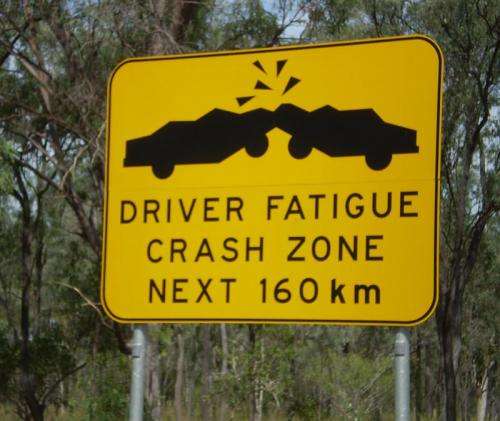Heavy-vehicle drivers' crash risk assessed

New research involving the Curtin-Monash Accident Research Centre has found that sleep apnea, while highly prevalent among heavy-vehicle drivers, is not associated with an increase in crashes.
However, the study did find a correlation between driving between midnight and 5:59am and a heightened risk of crashing, as well as driving for more than four hours without a break.
Curtin University Professor Lyn Meuleners says investigating risk factors is vital given the significant overrepresentation of heavy vehicles in road deaths in Australia and internationally.
"Surveys of long-distance heavy-vehicle drivers have found that excessive sleepiness is associated with overtime work, irregular schedules and a predominance of night-time driving," she says.
"These situations expose drivers to prolonged periods of wakefulness, prolonged periods of driving and circadian [body clock] factors known to increase the propensity to sleep.
"To date, however, many of the reported studies have not adjusted for factors related to the driver's quality or quantity of sleep prior to a crash, nor for the presence of a concomitant sleep disorder."
To look at these factors, researchers recruited 530 heavy-vehicle drivers who had recently crashed and 517 who had not from New South Wales and Western Australia.
The drivers filled out a 40-minute questionnaire relating to vehicle, employer and personal information, including health status, drug/alcohol use, sleep quantity and quality and self-reported measures of sleepiness.
Drivers then used a diagnostic device overnight to test for obstructive sleep apnea.
Research leader Professor Mark Stevenson of the Monash University Accident Research Centre says the results do not indicate sleep apnea to be a factor in crashes.
"Rates of sleep apnea as predicted by the portable monitor were not different between the two driver groups, with 'likely severe' sleep apnea being observed in 19 per cent of case drivers and 16 per cent of control drivers," he says.
"Scores from the Multivariate Apnea Prediction Index indicated that 'likely' sleep apnea, regardless of severity, was observed in 38 per cent of case drivers and 47 per cent of control drivers."
The study did show less-experienced drivers to be three times more likely to be involved in a crash compared with experienced drivers, and a greater than three-fold risk of crashing between midnight and 5:59am as compared with 6am to 12pm.
Drivers who used caffeinated drinks had three times lower odds of crashing, which is intriguing given that only 30 per cent of drivers involved in a crash reported consuming any caffeinated substances in the last month, compared with 56 per cent of non-crash drivers.















